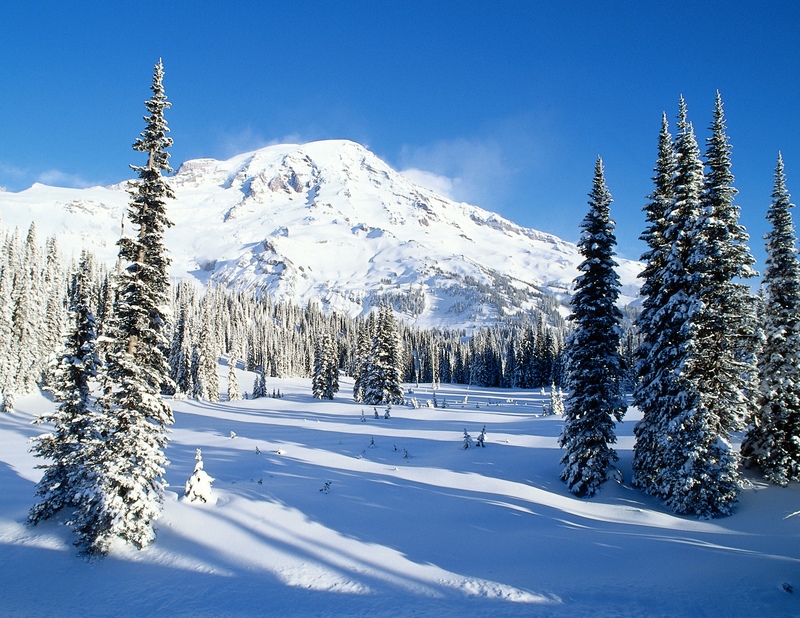Let It Snow! Let It Snow! Let It Snow!
RTB’s employees hail from all over America. Sandra and I are native Southern Californians accustomed to almost constant sunshine. Astrophysicist Jeff Zweerink comes from Missouri where white Christmases are reality, not dreams. While Jeff would much rather shovel snow from a driveway than deal with California’s maddening traffic; Sandra and I prefer to admire the (occasionally) snow-capped San Gabriel Mountains that loom over our commute route from the warm interior of our cars.
Of course, I enjoy visiting the mountains for wintertime fun, but snow is good for more than sledding and epic battles. Ice and snow play an important role in research on the age and history of the Earth—thus, impacting the creation debates, both between evolution and creation and between differing interpretations among Christians.
In an effort to explain certain geological and geochemical data, scientists proposed that Earth periodically experiences intense ice ages caused by variations in its orbit and resulting in glaciers that cover the planet completely. This is termed the “snowball Earth” hypothesis.
Research shows that extreme glaciations did take place millions of years ago, but something prevented them from turning the entire planet into a giant permanent snowball. The key to reversing this global freeze-out is a copious amount of organic carbon sediments on the ocean floor. Recent studies reveal that the presence of abundant carbon-producing life for millions of years has provided Earth with the perfect mechanism for preventing a disastrous, unending snowball effect.
Jeff points to this efficient and effective reversal of global ice ages as an example of God-directed fine-tuning. The delicate balance between glaciations, variations in Earth’s orbit, and the production of deep-ocean organic carbon “attest to the difficulty, from a naturalistic perspective, of attaining conditions suitable for life.”
(See Jeff’s article, “Design Feature Prevents Hard Snowball Earth.”)
Baby, it’s cold outside
Snow and ice provide a simple method for verifying the age of the Earth. The legitimacy of scientific dating methods is often a concern for Christians seeking to understand the relationship between faith and science. In particular, carbon-14 dating, used to determine the age of organic fossils, sometimes gets a bad rap from certain creationists who claim that it is an unreliable method. It is, in fact, very reliable, but there are other ways of calculating and verifying Earth’s age, including deep ice cores.
Snow layers in Greenland and Antarctica laid down on top of each other year after year (like tree-rings) provide excellent records of the past. Long cylindrical cores taken from the ice allow researchers to look back hundreds of thousands of years into Earth’s history. Not only do these cores provide valuable knowledge about past climates and atmospheric conditions, they also help confirm the age of the Earth as being much, much older that a few thousand or tens of thousands of years.
In an article published in 2005, RTB’s Hugh Ross reported on six deep ice cores, three from Greenland and three from Antarctica. As expected, each core allowed researchers to look far back into natural history. Hugh explained that the cores’ veracity as legitimate gages for the age of the Earth was verified by: (1) “telltale markers, such as volcanic ash” from the 1883 Krakatoa eruption and even the eruption of Mount Vesuvius that buried Pompeii; (2) correspondence between climatic changes caused by regular variations in Earth’s eccentricity and tilt and evidence in the cores; and (3) “radiometric dating of minerals embedded in the ice.”
(See Hugh’s article, “Deep Core Tests for the Age of the Earth.”)
Dr. Guillermo Gonzalez, associate professor of physics at Grove City College, Penn., and out-spoken advocate of intelligent design, sees deep ice cores, tree rings, and other natural time-keepers as evidence of God’s hand in fashioning Earth. He says our home planet’s “cyclical rhythms on time scales of days, months, seasons, years, centuries, periods, eras, and eons” make it an “ideal ‘recording device.’” This very measurability, not just of Earth, but of the whole universe, is what makes science possible. Gonzalez points out that the Judeo-Christian worldview supports the assumption—usually taken for granted—that there is “a unique correspondence between the physical universe and the human mind.”
(See Dr. Gonzalez’s article, “The Measurability of the Universe—A Record of the Creator’s Design.”)
Who knew there could be so much to contemplate in a snowball? But better not contemplate too long though, if you want to win the battle.
— Maureen





